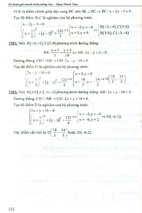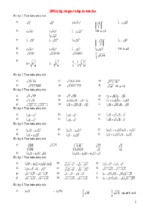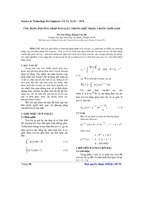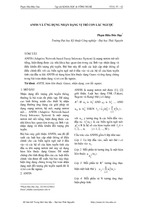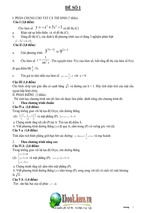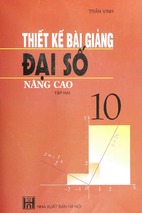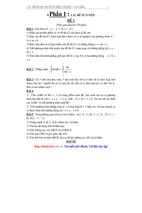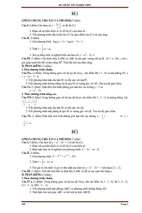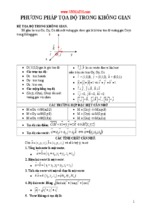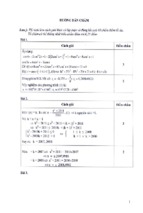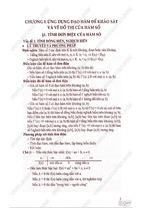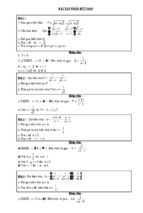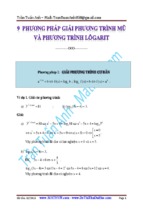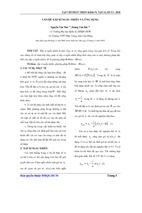Olympiad
Combinatorics
Pranav A. Sriram
August 2014
Chapter 1: Algorithms
1
Copyright notices
All USAMO and USA Team Selection Test problems in this chapter are
copyrighted by the Mathematical Association of America’s American
Mathematics Competitions.
© Pranav A. Sriram. This document is copyrighted by Pranav A. Sriram,
and may not be reproduced in whole or part without express written
consent from the author.
About the Author
Pranav Sriram graduated from high school at The International
School Bangalore, India, and will be a Freshman at Stanford
University this Fall.
Chapter 1: Algorithms
1
1. A LGORITHMS
Introduction
Put simply, an algorithm is a procedure or set of rules designed to
accomplish some task. Mathematical algorithms are indispensable
tools, and assist in financial risk minimization, traffic flow
optimization, flight scheduling, automatic facial recognition,
Google search, and several other services that impact our daily
lives.
Often, an algorithm can give us a deeper understanding of
mathematics itself. For instance, the famous Euclidean algorithm
essentially lays the foundation for the field of number theory. In
this chapter, we will focus on using algorithms to prove
combinatorial results. We can often prove the existence of an
object (say, a graph with certain properties or a family of sets
satisfying certain conditions) by giving a procedure to explicitly
construct it. These proofs are hence known as constructive proofs.
Our main goals in this chapter will be to study techniques for
designing algorithms for constructive proofs, and proving that
they actually work.
Olympiad Combinatorics
2
In this chapter, and throughout the book, the emphasis will be
on ideas. What can we observe while solving a given problem?
How can disparate ideas and observations be pieced together
cohesively to motivate a solution? What can we learn from the
solution of one problem, and how may we apply it to others in the
future? Each problem in this book is intended to teach some
lesson - this may be a combinatorial trick or a new way of looking
at problems. We suggest that you keep a log of new ideas and
insights into combinatorial structures and problems that you
encounter or come up with yourself.
Greedy Algorithms
Be fearful when others are greedy and greedy when others are
fearful - Warren Buffet
Greedy algorithms are algorithms that make the best possible
short term choices, hence in each step maximizing short term
gain. They aren’t always the optimal algorithm in the long run, but
often are still extremely useful. The idea of looking at extreme
elements (that are biggest, smallest, best, or worst in some
respect) is central to this approach.
Example 1
In a graph G with n vertices, no vertex has degree greater than Δ.
Show that one can color the vertices using at most Δ+1 colors,
such that no two neighboring vertices are the same color.
Answer:
We use the following greedy algorithm: arrange the vertices in an
arbitrary order. Let the colors be 1, 2, 3… Color the first vertex
with color 1. Then in each stage, take the next vertex in the order
and color it with the smallest color that has not yet been used on
any of its neighbors. Clearly this algorithm ensures that two
Chapter 1: Algorithms
3
adjacent vertices won’t be the same color. It also ensures that at
most Δ+1 colors are used: each vertex has at most Δ neighbors, so
when coloring a particular vertex v, at most Δ colors have been
used by its neighbors, so at least one color in the set {1, 2, 3, …,
Δ+1} has not been used. The minimum such color will be used for
the vertex v. Hence all vertices are colored using colors in the set
{1, 2, 3,…, Δ+1} and the problem is solved. ■
Remark: The “greedy” step here lies in always choosing the color
with the smallest number. Intuitively, we’re saving larger
numbers only for when we really need them.
Example 2 [Russia 2005, Indian TST 2012, France 2006]
In a 2 x n array we have positive reals such that the sum of the
numbers in each of the n columns is 1. Show that we can select
one number in each column such that the sum of the selected
numbers in each row is at most (n+1)/4.
0.4
0.6
0.7
0.3
0.9
0.1
0.2
0.8
0.6
0.4
0.4
0.6
0.3
0.7
0.1
0.9
Figure 1.1: 2xn array of positive reals, n=8
Answer:
A very trivial greedy algorithm would be to select the smaller
number in each column. Unfortunately, this won’t always work, as
can easily be seen from an instance in which all numbers in the
top row are 0.4. So we need to be more clever. Let the numbers in
the top row in non-decreasing order be a1, a2, …., an and the
corresponding numbers in the bottom row be b1, b2, …., bn (in nonincreasing order, since bi = 1 - ai). Further suppose that the sum of
the numbers in the top row is less than or equal to that of the
bottom row. The idea of ordering the variables is frequently used,
since it provides some structure for us to work with.
Our algorithm is as follows: Starting from a1, keep choosing the
smallest remaining element in the top row as long as possible. In
Olympiad Combinatorics
4
other words, select a1, a2, …, ak such that a1 + a2 + … + ak ≤
but
a1 + a2 + … + ak + ak+1 >
Now we cannot select any more from
the top row (as we would then violate the problem’s condition) so
in the remaining columns choose elements from the bottom row.
We just need to prove that the sum of the chosen elements in the
bottom row is at most
Note that ak+1 is at least the average of
a1, a2, …, ak, ak+1 which is more than
Hence bk+1 = (1 - ak+1) < 1 -
. But bk+1 is the largest of the
chosen elements in the bottom row. So the sum of the chosen
elements in the bottom row cannot exceed (1 ) x (n-k). We
leave it to the reader to check that this quantity cannot exceed
(n+1)/4. ■
Remark: One of the perks of writing a book is that I can leave
boring calculations to my readers.
Example 3
In a graph G with V vertices and E edges, show that there exists an
induced subgraph H with each vertex having degree at least E/V.
(In other words, a graph with average degree d has an induced
subgraph with minimum degree at least d/2).
Answer:
Note that the average degree of a vertex is 2E/V. Intuitively, we
should get rid of ‘bad’ vertices: vertices that have degree < E/V.
Thus a natural algorithm for finding such a subgraph is as follows:
start with the graph G, and as long as there exists a vertex with
degree < E/V, delete it. However, remember that while deleting a
vertex we are also deleting the edges incident to it, and in the
process vertices that were initially not ‘bad’ may become bad in
the subgraph formed. What if we end up with a graph with all
vertices bad? Fortunately, this won’t happen: notice that the ratio
Chapter 1: Algorithms
5
of edges/vertices is strictly increasing (it started at E/V and each
time we deleted a vertex, less than E/V edges were deleted by the
condition of our algorithm). Hence, it is impossible to reach a
stage when only 1 vertex is remaining, since in this case the
edges/vertices ratio is 0. So at some point, our algorithm must
terminate, leaving us with a graph with more than one vertex, all
of whose vertices have degree at least E/V. ■
Remark: This proof used the idea of monovariants, which we will
explore further in the next section.
The next problem initially appears to have nothing to do with
algorithms, but visualizing what it actually means allows us to
think about it algorithmically. The heuristics we develop lead us
to a very simple algorithm, and proving that it works isn’t hard
either.
Example 4 [IMO shortlist 2001, C4]
A set of three nonnegative integers {x, y, z} with x < y < z satisfying
{z-y, y-x} = {1776, 2001} is called a historic set. Show that the set
of all nonnegative integers can be written as a disjoint union of
historic sets.
Remark: The problem is still true if we replace {1776, 2001} with
an arbitrary pair of distinct positive integers {a, b}. These
numbers were chosen since IMO 2001 took place in USA, which
won independence in the year 1776.
Answer:
Let 1776 = a, 2001 =b. A historic set is of the form {x, x+a, x+a+b}
or {x, x+b, x+a+b}. Call these small sets and big sets respectively.
Essentially, we want to cover the set of nonnegative integers using
historic sets. To construct such a covering, we visualize the
problem as follows: let the set of nonnegative integers be written
in a line. In each move, we choose a historic set and cover these
numbers on the line. Every number must be covered at the end of
our infinite process, but no number can be covered twice (the
Olympiad Combinatorics
6
historic sets must be disjoint). We have the following heuristics, or
intuitive guidelines our algorithm should follow:
Heuristic 1: At any point, the smallest number not yet covered is
the most “unsafe”- it may get trapped if we do not cover it (for
example, if x is the smallest number not yet covered but x+a+b has
been covered, we can never delete x). Thus in each move we
should choose x as the smallest uncovered number.
Heuristic 2: From heuristic 1, it follows that our algorithm should
prefer small numbers to big numbers. Thus it should prefer small
sets to big sets.
Based on these two simple heuristics, we construct the
following greedy algorithm that minimizes short run risk: in any
move, choose x to be the smallest number not yet covered. Use
the small set if possible; only otherwise use the big set. We now
show that this simple algorithm indeed works:
Suppose the algorithm fails (that is, we are stuck because using
either the small or big set would cover a number that has already
been covered) in the (n+1)th step. Let xi be the value chosen for x
in step i. Before the (n+1)th step, xn+1 hasn’t yet been covered, by
the way it is defined. xn+1 + a + b hasn’t yet been covered since it is
larger than all the covered elements (xn+1 > xi by our algorithm). So
the problem must arise due to xn+1 + a and xn+1 + b. Both of these
numbers must already be covered. Further, xn+1 + b must have
been the largest number in its set. Thus the smallest number in
this set would be xn+1 + b – (a+b) = xn+1 – a. But at this stage, xn+1
was not yet covered, so the small set should have been used and
xn+1 should have been covered in that step. This is a contradiction.
Thus our supposition is wrong and the algorithm indeed works. ■
Remark: In an official solution to this problem, the heuristics
would be skipped. Reading such a solution would leave you
thinking “Well that’s nice and everything, but how on earth would
anyone come up with that?” One of the purposes of this book is to
Chapter 1: Algorithms
7
show that Olympiad solutions don’t just “come out of nowhere”.
By including heuristics and observations in our solutions, we hope
that readers will see the motivation and the key ideas behind
them.
Invariants and Monovariants
Now we move on to two more extremely important concepts:
invariants and monovariants. Recall that a monovariant is a
quantity that changes monotonically (either it is non-increasing or
non-decreasing), and an invariant is a quantity that doesn’t
change. These concepts are especially useful when studying
combinatorial processes. While constructing algorithms, they help
us in several ways. Monovariants often help us answer the
question “Well, what do we do now?” In the next few examples,
invariants and monovariants play a crucial role in both
constructing the algorithm and ensuring that it works.
Example 5 [IMO shortlist 1989]
A natural number is written in each square of an m x n
chessboard. The allowed move is to add an integer k to each of
two adjacent numbers in such a way that nonnegative numbers
are obtained (two squares are adjacent if they share a common
side). Find a necessary and sufficient condition for it to be
possible for all the numbers to be zero after finitely many
operations.
Answer:
Note that in each move, we are adding the same number to 2
squares, one of which is white and one of which is black (if the
chessboard is colored alternately black and white). If Sb and Sw
denote the sum of numbers on black and white squares
respectively, then Sb – Sw is an invariant. Thus if all numbers are 0
at the end, Sb – Sw = 0 at the end and hence Sb – Sw = 0 in the
Olympiad Combinatorics
8
beginning as well. This condition is thus necessary; now we prove
that it is sufficient.
8
7
5
7
3
2
6
2
5
4
1
6
→
8
7
5
7
3
2
2
2
5
0
1
6
Figure 1.2: A move on the mxn board
Suppose a, b, c are numbers in cells A, B, C respectively, where
A, B, C are cells such that A and C are both adjacent to B. If a ≤ b,
we can add (-a) to both a and b, making a 0. If a ≥ b, then add (a-b)
to b and c. Then b becomes a, and now we can add (-a) to both of
them, making them 0. Thus we have an algorithm for reducing a
positive integer to 0. Apply this in each row, making all but the
last 2 entries 0. Now all columns have only zeroes except the last
two. Now apply the algorithm starting from the top of these
columns, until only two adjacent nonzero numbers remain. These
last two numbers must be equal since Sb = Sw . Thus we can reduce
them to 0 as well. ■
The solution to the next example looks long and complicated, but
it is actually quite intuitive and natural. We have tried to motivate
each step, and show that each idea follows quite naturally from
the previous ones.
Example 6 [New Zealand IMO Training, 2011]
There are 2n people seated around a circular table, and m cookies
are distributed among them. The cookies can be passed under the
following rules:
(a) Each person can only pass cookies to his or her neighbors
(b) Each time someone passes a cookie, he or she must also eat a
cookie
Let A be one of these people. Find the least m such that no matter
how m cookies are distributed initially, there is a strategy to pass
cookies so that A receives at least one cookie.
Chapter 1: Algorithms
9
Answer:
We begin by labeling the people A–n+1, A–n+2, …., A0, A1, A2, …, An,
such that A = A0. Also denote A-n = An. We assign weight 1/2|i| to
each cookie held by person Ai. Thus for example, if A3 passes a
cookie to A2, that cookie’s weight increases from 1/8 to 1/4. Note that
A3 must also eat a cookie (of weight 1/8) in this step. Thus we see in
this case the sum of the weights of all the cookies has remained
the same. More precisely, if Ai has ai cookies for each i, then the
total weight of all cookies is
W =∑
Whenever a cookie is passed towards A0 (from A±i to A±(i-1) for i
positive) one cookie is eaten and another cookie doubles its
weight, so the total weight remains invariant. If a cookie is passed
away from A, then the total weight decreases. Thus the total
weight is indeed a monovariant.
A -1
A0
A1
A -2
A2
A -3
A3
A -4
A4
A -5
A6
A5
Figure 1.3: Labeling scheme to create a monovariant (n=5)
Olympiad Combinatorics
10
If m < 2n, then if all the cookies are initially given to An, the
n
initial total weight is m/2 < 1. Therefore the total weight is
always less than 1 (since it can never increase), so A0 cannot
receive a cookie (if A0 received a cookie it would have weight 1).
n
Thus we must have m ≥ 2 .
n
We now show that for m ≥ 2 , we can always ensure that A0
gets a cookie. Intuitively, we have the following heuristic:
Our algorithm should never pass away from A0, otherwise we will
decrease our monovariant. Thus in each step we should pass
towards A0.
This heuristic, however, does not tell us which way An should
pass a cookie, as both directions are towards A0 (An and A0 are
diametrically opposite). This leads us to consider a new quantity
in order to distinguish between the two directions that An can pass
to. Let W+ be the sum of the weights of cookies held by A0, A1, A2,
…., An and let W- be the sum of the weights of cookies held by A0,
A-1, A-2, …., A-n. Assume WLOG W+ ≥ W-. Then this suggests that we
should make An pass cookies only to An-1 and that we should only
work in the semicircle containing nonnegative indices, since this
is the semicircle having more weight. Thus our algorithm is to
make An pass as many cookies as possible to An-1, then make An-1
pass as many cookies as possible to An-2, and so on until A0 gets a
cookie. But this works if and only if W+ ≥ 1: W+ ≥ 1 is certainly
necessary since W+ is a monovariant under our algorithm, and we
now show it is sufficient.
Suppose W+ ≥ 1. Note that our algorithm leaves W+ invariant.
Suppose our algorithm terminates, that is, we cannot pass
anymore cookies from any of the Ai’s with i positive, and A0
doesn’t have any cookies. Then A1, A2, …., An all have at most 1
cookie at the end (if they had more than one, they could eat one
and pass one and our algorithm wouldn’t have terminated). Then
Chapter 1: Algorithms
11
at this point W+ ≤ ½ + ¼ + ….. + 1/2n < 1, contradicting the fact that
W+ is invariant and ≥ 1. Thus W+ ≥ 1 is a sufficient condition for
our algorithm to work.
Finally, we prove that we indeed have W+ ≥ 1. We assumed W+ ≥
n-1
W-. Now simply note that each cookie contributes at least 1/2 to
n-1
the sum (W+ + W-), because each cookie has weight at least 1/2
except for cookies at An. However, cookies at An are counted twice
since they contribute to both W+ and W-, so they also contribute
1/2n-1 to the sum. Hence, since we have at least 2n cookies, W+ + W≥ 2, so W+ ≥ 1 and we are done. ■
The next example demonstrates three very useful ideas:
monovariants, binary representation and the Euclidean algorithm.
All of these are very helpful tools.
Example 7 [IMO shortlist 1994, C3]
Peter has 3 accounts in a bank, each with an integral number of
dollars. He is only allowed to transfer money from one account to
another so that the amount of money in the latter is doubled.
Prove that Peter can always transfer all his money into two
accounts. Can he always transfer all his money into one account?
Answer:
The second part of the question is trivial - if the total number of
dollars is odd, it is clearly not always possible to get all the money
into one account. Now we solve the first part. Let A, B, C with A ≤ B
≤ C be the number of dollars in the account 1, account 2 and
account 3 respectively at a particular point of time. If A = 0
initially, we are done so assume A > 0. As we perform any
algorithm, the values of A, B and C keep changing. Our aim is to
monotonically strictly decrease the value of min (A, B, C). This will
ensure that we eventually end up with min (A, B, C) = 0 and we
will be done. Now, we know a very simple and useful algorithm
that monotonically reduces a number- the Euclidean algorithm. So
let B = qA + r with 0 r < A. Our aim now is to reduce the number
Olympiad Combinatorics
12
of dollars in the second account from B to r. Since r < A, we would
have reduced min (A, B, C), which was our aim.
Now, since the question involves doubling certain numbers, it
is a good idea to consider binary representations of numbers. Let
k
q = m0 + 2m1 + …. + 2 mk be the binary representation of q, where
mi = 0 or 1. To reduce B to r, in step i of our algorithm, we transfer
money to account 1. The transfer is from account 2 if mi-1 = 1 and
from account 3 if mi-1 = 0. The number of dollars in the first
account starts with A and keeps doubling in each step. Thus we
end up transferring A(m0 + 2m1 + …. + 2kmk) = Aq dollars from
account 2 to account 1, and we are left with B – Aq = r dollars in
account 2. We have thus succeeded in reducing min (A, B, C) and
so we are done. ■
Now we look at a very challenging problem that can be solved
using monovariants.
Example 8 [APMO 1997, Problem 5]
n people are seated in a circle. A total of nk coins have been
distributed among them, but not necessarily equally. A move is the
transfer of a single coin between two adjacent people. Find an
algorithm for making the minimum possible number of moves
which result in everyone ending up with the same number of
coins.
Answer:
We want each person to end up with k coins. Let the people be
labeled from 1, 2, …, n in order (note that n is next to 1 since they
are sitting in a circle). Suppose person i has ci coins. We introduce
the variable di = ci – k, since this indicates how close a person is to
having the desired number of coins. Consider the quantity
X = |d1| + |d1 + d2| + |d1 + d2 + d3| + … + |d1 + d2 + … + dn-1|
Clearly X = 0 if and only if everyone has k coins, so our goal is to
Chapter 1: Algorithms
13
make X = 0. The reason for this choice of X is that moving a coin
between person j and person j + 1 for 1 ≤ j ≤ n -1 changes X by
exactly 1 as only the term |d1 + d2 + … + dj| will be affected. Hence
X is a monovariant and is fairly easy to control (except when
moving a coin from 1 to n or vice versa). Let sj = d1 + d2 + … + dj.
We claim that as long as X > 0 it is always possible to reduce X
by 1 by a move between j and j +1 for some 1 ≤ j ≤ n -1. We use the
following algorithm. Assume WLOG d1 ≥ 1. Take the first j such
that dj+1 < 0. If sj > 0, then simply make a transfer from j to j + 1.
This reduces X by one since it reduces the term |sj| by one. The
other possibility is sj = 0, which means d1 = d2 = … = dj = 0 (recall
that dj+1 is the first negative term). In this case, take the first m >
i+1 such that dm ≥ 0. Then dm-1 < 0 by the assumption on m, so we
move a coin from m to (m-1). Note that all terms before dm were
either 0 or less than 0 and dm-1 < 0 , so sm-1 was less than 0. Our
move has increased sm-1 by one, and has hence decreased |sm-1| by
one, so we have decreased X by one.
Thus at any stage we can always decrease X by at least one by
moving between j and j +1 for some 1 ≤ j ≤ n -1. We have not yet
considered the effect of a move between 1 and n. Thus our full
algorithm is as follows: At any point of time, if we can decrease X
by moving a coin from 1 to n or n to 1, do this. Otherwise, decrease
X by 1 by the algorithm described in the above paragraph. ■
Sometimes while creating algorithms that monotonically decrease
(or increase) a quantity, we run into trouble in particular cases
and our algorithm doesn’t work. We can often get around these
difficulties as follows. Suppose we want to monotonically
decrease a particular quantity. Call a position good if we can
decrease the monovariant with our algorithm. Otherwise, call the
position bad. Now create an algorithm that converts bad positions
into good positions, without increasing our monovariant. We use
the first algorithm when possible, and then if we are stuck in a bad
position, use the second algorithm to get back to a good position.
Then we can again use the first algorithm. The next example
Olympiad Combinatorics
14
(which is quite hard) demonstrates this idea.
Example 9 [USAMO 2003-6]
At the vertices of a regular hexagon are written 6 nonnegative
integers whose sum is 2003. Bert is allowed to make moves of the
following form: he may pick a vertex and replace the number
written there by the absolute value of the difference between the
numbers at the neighboring vertices. Prove that Bert can make a
sequence of moves, after which the number 0 appears at all 6
vertices.
Remark: We advise the reader to follow this solution with a paper
and pen, and fill in the details that have been left for the reader.
We first suggest that the reader try some small cases (with 2003
replaced by smaller numbers).
Answer:
Our algorithm uses the fact that 2003 is odd. Let the sum of a
position be the sum of the 6 numbers and the maximum denote
the value of the maximum of the 6 numbers. Let A, B, C, D, E, F be
the numbers at the 6 vertices in that order. Our aim is to
monotonically decrease the maximum. Note that the maximum
can never increase.
We need two sub-algorithms:
(i) “Good position” creation: from a position with odd sum, go to
a position with exactly one odd number
(ii) Monovariant reduction: from a position with exactly one odd
number, go to a position with odd sum and strictly smaller
maximum, or go to the all 0 position.
For (i), since (A + B + C + D + E + F) is odd, assume WLOG that A
+ C + E is odd. If exactly one of A, C, E is odd, suppose A is odd.
Then make the following sequence of moves: B, F, D A, F (here we
denote a move by the vertex at which the move is made). This
way, we end up with a situation in which only B is odd and the
Chapter 1: Algorithms
15
rest become even (check this), and we are done with step (i). The
other possibility is that all of A, C and E are odd. In this case make
the sequence of moves (B, D, F, C, E). After this only A is odd
(check this).
Now we are ready to apply step (ii), the step that actually
decreases our monovariant. At this point, only one vertex contains
an odd number; call this vertex A. Again we take two cases. If the
maximum is even, then it is one of B, C, D, E or F. Now make moves
at B, C, D, E and F in this order. (The reader should check that this
works, that is, this sequence of moves decreases the maximum
and ensures that the sum is odd). If the maximum is odd, then it is
A. If C = E = 0, then the sequence of moves (B, F, D, A, B, F) leaves
us with all numbers 0 and we are done. Otherwise, suppose at
least one of C and E is nonzero so suppose C > 0 (the case E > 0 is
similar). In this case, make the moves (B, F, A, F). The reader can
check that this decreases the maximum and leaves us with odd
sum.
Thus starting with odd sum, we apply (i) if needed, after which
we apply (ii). This decreases the maximum, and also leaves us
again with odd sum (or in some cases it leaves us with all 0s and
we are done), so we can repeat the entire procedure until the
maximum eventually becomes 0. ■
Miscellaneous Examples
Now we look at a few more problems involving moves that don’t
directly use monovariants or greedy algorithms. These problems
can often be solved by algorithms that build up the required
configuration in steps. Sometimes, the required algorithm
becomes easier to find after making some crucial observations or
proving an auxiliary lemma. But in lots of cases, all a
combinatorics problem needs is patience and straightforward
Olympiad Combinatorics
16
logic, as the next example shows. Here again the solution looks
long but most of what is written is just intended to motivate the
solution.
Example 10 [China 2010, Problem 5]
There are some (finite number of) cards placed at the points A1,
A2, …, An and O, where n ≥ 3. We can perform one of the following
operations in each step:
(1) If there are more than 2 cards at some point Ai, we can remove
3 cards from this point and place one each at Ai-1, Ai+1 and O
(here A0 = An and An+1 = A1)
(2) If there are at least n cards at O, we can remove n cards from O
and place one each at A1, A2, …, An.
Show that if the total number of cards is at least n2+3n+1, we can
make the number of cards at each vertex at least n + 1 after
finitely many steps.
Answer:
Note that the total number of cards stays the same. We make a few
observations:
(a) We should aim to make the number of cards at each Ai equal
or close to equal, since if in the end some point has lots of
cards, some other point won’t have enough.
(b) We can make each of the Ai’s have 0, 1 or 2 cards.
Proof: repeatedly apply operation (1) as long as there is a
point with at least 3 cards. This process must terminate, since
the number of coins in O increases in each step but cannot
increase indefinitely. This is a good idea since the Ai’s would
now have a ‘close to equal’ number of coins, which is a good
thing by observation a).
(c) From observation b), we see that it is also possible to make
Chapter 1: Algorithms
17
each of the Ai‘s have 1, 2, or 3 cards (from the stage where
each vertex has 0, 1 or 2 cards, just apply operation (2) once).
This still preserves the ‘close to equal’ property, but gives us
some more flexibility since we are now able to apply
operation 1.
(d) Based on observation c), we make each of the Ai’s have 1, 2 or
3 cards. Suppose x of the Ai’s have 1 card, y of the Ai’s have 2
cards and z of the Ai’s have 3 cards. The number of cards at O
is then at least (n2+3n+1) - (x +2y + 3z). Since x + y + z = n, (x +
2y + 3z) = (2x + 2y + 2z) + z – x = 2n + z – x ≤ 2n if x ≥ z. Thus if
x ≥ z, O will have at least (n2+3n+1) – 2n = n2+n + 1 cards. Now
we can apply operation (2) n times. Then all the Ai’s will now
have at least n + 1 cards (they already each had at least 1
card), and O will have at least n2 + n + 1 – n2 = n + 1 cards and
we will be done.
Thus, based on observation d), it suffices to find an algorithm
that starts with a position in which each of the Ai’s have 1, 2, or 3
cards and ends in a position in which each of the Ai’s have 1, 2, or
3 cards but the number of points having 3 cards is not more than
the number of points having 1 card. This is not very difficult- the
basic idea is to ensure that between any two points having 3
cards, there is a point containing 1 card. We can do this as follows:
If there are consecutive 3’s in a chain, like (x, 3, 3, ….., 3, y) with
(x, y ≠3), apply operation (1) on all the points with 3 cards to get
(x + 1, 1, 2, 2, ……, 2, 1, y+1). Thus we can ensure that there are no
adjacent 3’s. Now suppose there are two 3’s with only 2’s between
them, like (x, 3, 2, 2, 2,…,2, 3, y) with x, y ≠3. After doing operation
(1) first on the first 3, then on the point adjacent to it that has
become a 3 and so on until the point before y, we get the sequence
(x+1, 1, 1,…,1, y+1).
Thus we can repeat this procedure as long as there exist two
3’s that do not have a 1 between them. Note that the procedure
- Xem thêm -


